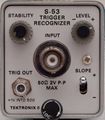S-53: Difference between revisions
No edit summary |
No edit summary |
||
| Line 29: | Line 29: | ||
{{Spec | Trigger-out signal | 1 V into 50 Ω with 600 mV/ns slew rate, [[BSM connector]] }} | {{Spec | Trigger-out signal | 1 V into 50 Ω with 600 mV/ns slew rate, [[BSM connector]] }} | ||
{{EndSpecs}} | {{EndSpecs}} | ||
==Links== | |||
{{Documents|Link=S-53}} | |||
{{PatentLinks|S-53}} | |||
==Internals== | ==Internals== | ||
Latest revision as of 10:54, 19 June 2024
The Tektronix S-53 Trigger Recognizer head can be used in the right bay of the 7S12 TDR/Sampler plug-in or externally in a type 285 enclosure. It essentially contains the entire trigger circuit of an oscilloscope.
Key Specifications
| Bandwidth | 1 GHz |
|---|---|
| Input impedance | 50 Ω BNC connector |
| Sensitivity | 10 mV to 1 V (p-p) |
| Jitter | max. 15 ps or less (from input signal to trigger-out) |
| Delay | 15 ns (from input signal to trigger-out) |
| Trigger-out signal | 1 V into 50 Ω with 600 mV/ns slew rate, BSM connector |
Links
Documents Referencing S-53
- (no results)
Internals
The S-53 uses tunnel diode triggering with an amplifier before the tunnel diode.
The signal first passes through a compensated NPN differential amplifier, Q10 and Q12, which provides an adjustable trigger offset voltage and trigger polarity selection. Switching diodes CR6 and CR8 are used for selecting the trigger polarity. The differential amplifier (i.e., phase splitter) generates both phases, inverted and non-inverted. Depending on the position of the trigger polarity switch, one or the other of the phases is shunted by 200 Ω resistor. The two signals are buffered by common-base amplifiers Q20 and Q22, whose collector currents are summed. R25 sets up a bias current on trigger tunnel diode CR25. The extra current from Q20 or Q22 pushes CR25 over its peak current, and it switches to the high voltage state.
Pictures
-
-
-
-
Front
-
Front
-
-
-
-
-
-
-
Schematic













